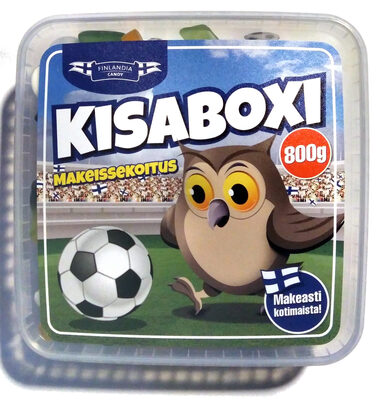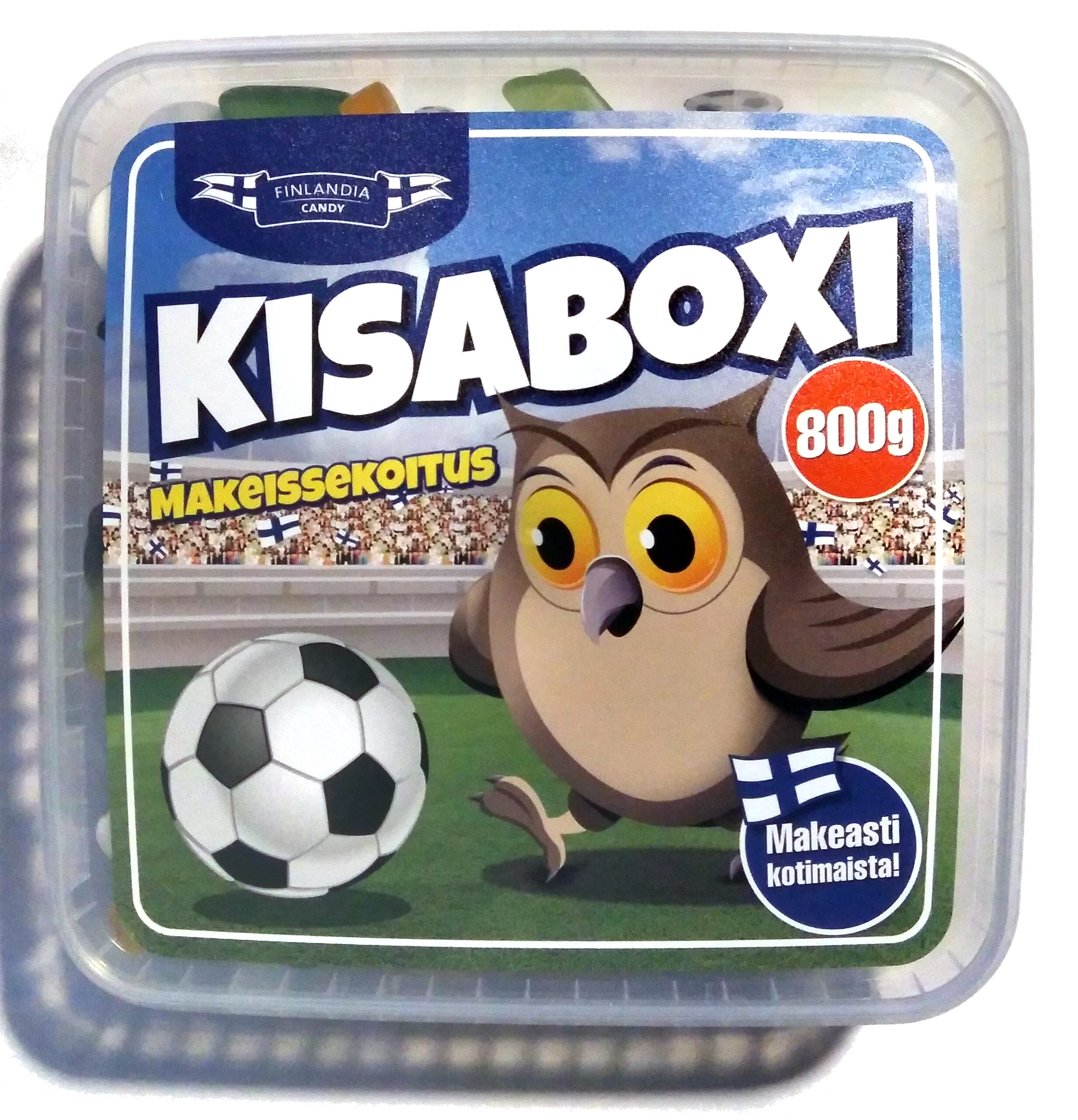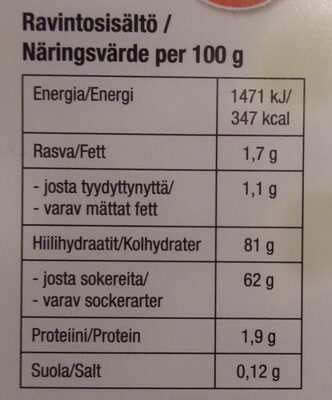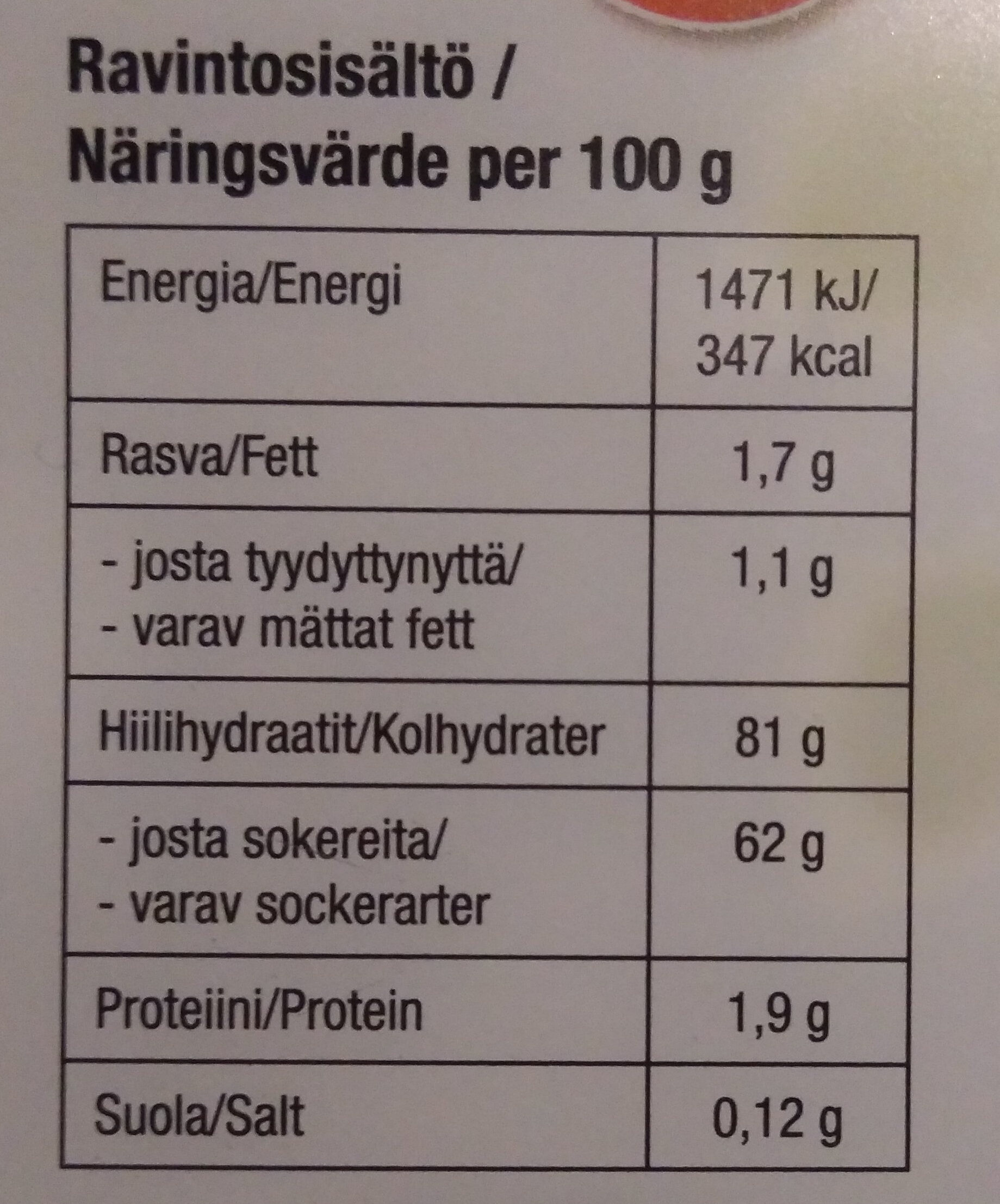Help us make food transparency the norm!
As a non-profit organization, we depend on your donations to continue informing consumers around the world about what they eat.
The food revolution starts with you!
Kisaboxi - Finlandia Candy - 800g
Kisaboxi - Finlandia Candy - 800g
This product page is not complete. You can help to complete it by editing it and adding more data from the photos we have, or by taking more photos using the app for Android or iPhone/iPad. Thank you!
×
Barcode: 6430050765316 (EAN / EAN-13)
Common name: Makeissekoitus
Quantity: 800g
Packaging: Plastic, Pp-polypropylene
Brands: Finlandia Candy
Categories: Snacks, Sweet snacks, Cocoa and its products, Confectioneries, Chocolate candies, Bonbons
Labels, certifications, awards:
Avainlippu
Manufacturing or processing places: Pajatie 5B, 21870, Riihikoski
Stores: Lidl
Countries where sold: Finland
Matching with your preferences
Health
Ingredients
-
37 ingredients
: Sokeri, glukoosisiirappi, maissitärkkelys, liivate, kaakaovoi, vehnäjauho, happamuudensäätöaineet (E330, E331), muunnettu tärkkelys, täysmaitojauhe, kaakaomassa, melassi, ammoniumkloridi (salmiakki), lakritsiuute, aromit, värit (E100, E141, E150c, E153, E160a, E163, E171), pintakäsittelyaine (kasviöljy (kookos, rypsi), E903), sakeuttamisaine (E414), rasvaton maitojauhe, emulgointiaine (lesitiini (auringonkukka, rypsi)).Allergens: Gluten, Milk
Food processing
-
Ultra processed foods
Elements that indicate the product is in the 4 - Ultra processed food and drink products group:
- Additive: E100 - Curcumin
- Additive: E141 - Copper complexes of chlorophylls and chlorophyllins
- Additive: E14XX - Modified Starch
- Additive: E150c - Ammonia caramel
- Additive: E153 - Vegetable carbon
- Additive: E160a - Carotene
- Additive: E163 - Anthocyanins
- Additive: E171 - Titanium dioxide
- Additive: E322 - Lecithins
- Additive: E414 - Acacia gum
- Additive: E428 - Gelatine
- Additive: E903 - Carnauba wax
- Ingredient: Colour
- Ingredient: Emulsifier
- Ingredient: Flavouring
- Ingredient: Glazing agent
- Ingredient: Glucose
- Ingredient: Glucose syrup
- Ingredient: Thickener
Food products are classified into 4 groups according to their degree of processing:
- Unprocessed or minimally processed foods
- Processed culinary ingredients
- Processed foods
- Ultra processed foods
The determination of the group is based on the category of the product and on the ingredients it contains.
Additives
-
E160a - Carotene
Carotene: The term carotene -also carotin, from the Latin carota, "carrot"- is used for many related unsaturated hydrocarbon substances having the formula C40Hx, which are synthesized by plants but in general cannot be made by animals -with the exception of some aphids and spider mites which acquired the synthesizing genes from fungi-. Carotenes are photosynthetic pigments important for photosynthesis. Carotenes contain no oxygen atoms. They absorb ultraviolet, violet, and blue light and scatter orange or red light, and -in low concentrations- yellow light. Carotenes are responsible for the orange colour of the carrot, for which this class of chemicals is named, and for the colours of many other fruits, vegetables and fungi -for example, sweet potatoes, chanterelle and orange cantaloupe melon-. Carotenes are also responsible for the orange -but not all of the yellow- colours in dry foliage. They also -in lower concentrations- impart the yellow coloration to milk-fat and butter. Omnivorous animal species which are relatively poor converters of coloured dietary carotenoids to colourless retinoids have yellowed-coloured body fat, as a result of the carotenoid retention from the vegetable portion of their diet. The typical yellow-coloured fat of humans and chickens is a result of fat storage of carotenes from their diets. Carotenes contribute to photosynthesis by transmitting the light energy they absorb to chlorophyll. They also protect plant tissues by helping to absorb the energy from singlet oxygen, an excited form of the oxygen molecule O2 which is formed during photosynthesis. β-Carotene is composed of two retinyl groups, and is broken down in the mucosa of the human small intestine by β-carotene 15‚15'-monooxygenase to retinal, a form of vitamin A. β-Carotene can be stored in the liver and body fat and converted to retinal as needed, thus making it a form of vitamin A for humans and some other mammals. The carotenes α-carotene and γ-carotene, due to their single retinyl group -β-ionone ring-, also have some vitamin A activity -though less than β-carotene-, as does the xanthophyll carotenoid β-cryptoxanthin. All other carotenoids, including lycopene, have no beta-ring and thus no vitamin A activity -although they may have antioxidant activity and thus biological activity in other ways-. Animal species differ greatly in their ability to convert retinyl -beta-ionone- containing carotenoids to retinals. Carnivores in general are poor converters of dietary ionone-containing carotenoids. Pure carnivores such as ferrets lack β-carotene 15‚15'-monooxygenase and cannot convert any carotenoids to retinals at all -resulting in carotenes not being a form of vitamin A for this species-; while cats can convert a trace of β-carotene to retinol, although the amount is totally insufficient for meeting their daily retinol needs.Source: Wikipedia
-
E163 - Anthocyanins
Anthocyanin: Anthocyanins -also anthocyans; from Greek: ἄνθος -anthos- "flower" and κυάνεος/κυανοῦς kyaneos/kyanous "dark blue"- are water-soluble vacuolar pigments that, depending on their pH, may appear red, purple, or blue. Food plants rich in anthocyanins include the blueberry, raspberry, black rice, and black soybean, among many others that are red, blue, purple, or black. Some of the colors of autumn leaves are derived from anthocyanins.Anthocyanins belong to a parent class of molecules called flavonoids synthesized via the phenylpropanoid pathway. They occur in all tissues of higher plants, including leaves, stems, roots, flowers, and fruits. Anthocyanins are derived from anthocyanidins by adding sugars. They are odorless and moderately astringent. Although approved to color foods and beverages in the European Union, anthocyanins are not approved for use as a food additive because they have not been verified as safe when used as food or supplement ingredients. There is no conclusive evidence anthocyanins have any effect on human biology or diseases.Source: Wikipedia
-
E171 - Titanium dioxide
Titanium dioxide: Titanium dioxide, also known as titaniumIV oxide or titania, is the naturally occurring oxide of titanium, chemical formula TiO2. When used as a pigment, it is called titanium white, Pigment White 6 -PW6-, or CI 77891. Generally, it is sourced from ilmenite, rutile and anatase. It has a wide range of applications, including paint, sunscreen and food coloring. When used as a food coloring, it has E number E171. World production in 2014 exceeded 9 million metric tons. It has been estimated that titanium dioxide is used in two-thirds of all pigments, and the oxide has been valued at $13.2 billion.Source: Wikipedia
-
E322 - Lecithins
Lecithins are natural compounds commonly used in the food industry as emulsifiers and stabilizers.
Extracted from sources like soybeans and eggs, lecithins consist of phospholipids that enhance the mixing of oil and water, ensuring smooth textures in various products like chocolates, dressings, and baked goods.
They do not present any known health risks.
-
E322i - Lecithin
Lecithins are natural compounds commonly used in the food industry as emulsifiers and stabilizers.
Extracted from sources like soybeans and eggs, lecithins consist of phospholipids that enhance the mixing of oil and water, ensuring smooth textures in various products like chocolates, dressings, and baked goods.
They do not present any known health risks.
-
E330 - Citric acid
Citric acid is a natural organic acid found in citrus fruits such as lemons, oranges, and limes.
It is widely used in the food industry as a flavor enhancer, acidulant, and preservative due to its tart and refreshing taste.
Citric acid is safe for consumption when used in moderation and is considered a generally recognized as safe (GRAS) food additive by regulatory agencies worldwide.
-
E331 - Sodium citrates
Sodium citrate: Sodium citrate may refer to any of the sodium salts of citrate -though most commonly the third-: Monosodium citrate Disodium citrate Trisodium citrateThe three forms of the salt are collectively known by the E number E331. Sodium citrates are used as acidity regulators in food and drinks, and also as emulsifiers for oils. They enable cheeses to melt without becoming greasy.Source: Wikipedia
-
E414 - Acacia gum
Gum arabic: Gum arabic, also known as acacia gum, arabic gum, gum acacia, acacia, Senegal gum and Indian gum, and by other names, is a natural gum consisting of the hardened sap of various species of the acacia tree. Originally, gum arabic was collected from Acacia nilotica which was called the "gum arabic tree"; in the present day, gum arabic is collected from acacia species, predominantly Acacia senegal and Vachellia -Acacia- seyal; the term "gum arabic" does not indicate a particular botanical source. In a few cases so‐called "gum arabic" may not even have been collected from Acacia species, but may originate from Combretum, Albizia or some other genus. Producers harvest the gum commercially from wild trees, mostly in Sudan -80%- and throughout the Sahel, from Senegal to Somalia—though it is historically cultivated in Arabia and West Asia. Gum arabic is a complex mixture of glycoproteins and polysaccharides. It is the original source of the sugars arabinose and ribose, both of which were first discovered and isolated from it, and are named after it. Gum arabic is soluble in water. It is edible, and used primarily in the food industry as a stabilizer, with EU E number E414. Gum arabic is a key ingredient in traditional lithography and is used in printing, paint production, glue, cosmetics and various industrial applications, including viscosity control in inks and in textile industries, though less expensive materials compete with it for many of these roles. While gum arabic is now produced throughout the African Sahel, it is still harvested and used in the Middle East.Source: Wikipedia
-
E903 - Carnauba wax
Carnauba wax: Carnauba -; Portuguese: carnaúba [kaʁnɐˈubɐ]-, also called Brazil wax and palm wax, is a wax of the leaves of the palm Copernicia prunifera -Synonym: Copernicia cerifera-, a plant native to and grown only in the northeastern Brazilian states of Piauí, Ceará, Maranhão, Bahia, and Rio Grande do Norte. It is known as "queen of waxes" and in its pure state, usually comes in the form of hard yellow-brown flakes. It is obtained from the leaves of the carnauba palm by collecting and drying them, beating them to loosen the wax, then refining and bleaching the wax.Source: Wikipedia
Ingredients analysis
-
May contain palm oil
Ingredients that may contain palm oil: E160a
-
Non-vegan
Non-vegan ingredients: E428, Whole milk powder, Skimmed milk powder
-
Non-vegetarian
Non-vegetarian ingredients: E428
-
Details of the analysis of the ingredients
: Sokeri, glukoosisiirappi, maissitärkkelys, liivate, kaakaovoi, _vehnäjauho_, happamuudensäätöaineet (e330, e331), muunnettu tärkkelys, _täysmaitojauhe_, kaakaomassa, melassi, ammoniumkloridi (salmiakki), lakritsiuute, aromit, värit (e100, e141, e150c, e153, e160a, e163, e171), pintakäsittelyaine (kasviöljy (kookos, rypsi), e903), sakeuttamisaine (e414), rasvaton maitojauhe, emulgointiaine (lesitiini (auringonkukka, rypsi))- Sokeri -> en:sugar - vegan: yes - vegetarian: yes - ciqual_proxy_food_code: 31016 - percent_min: 5.26315789473684 - percent_max: 100
- glukoosisiirappi -> en:glucose-syrup - vegan: yes - vegetarian: yes - ciqual_proxy_food_code: 31016 - percent_min: 0 - percent_max: 50
- maissitärkkelys -> en:corn-starch - vegan: yes - vegetarian: yes - ciqual_food_code: 9510 - percent_min: 0 - percent_max: 33.3333333333333
- liivate -> en:e428 - vegan: no - vegetarian: no - percent_min: 0 - percent_max: 25
- kaakaovoi -> en:cocoa-butter - vegan: yes - vegetarian: yes - ciqual_food_code: 16030 - percent_min: 0 - percent_max: 20
- _vehnäjauho_ -> en:wheat-flour - vegan: yes - vegetarian: yes - ciqual_proxy_food_code: 9410 - percent_min: 0 - percent_max: 16.6666666666667
- happamuudensäätöaineet -> en:acidity-regulator - percent_min: 0 - percent_max: 14.2857142857143
- e330 -> en:e330 - vegan: yes - vegetarian: yes - percent_min: 0 - percent_max: 14.2857142857143
- e331 -> en:e331 - vegan: yes - vegetarian: yes - percent_min: 0 - percent_max: 7.14285714285714
- muunnettu tärkkelys -> en:modified-starch - vegan: yes - vegetarian: yes - ciqual_proxy_food_code: 9510 - percent_min: 0 - percent_max: 12.5
- _täysmaitojauhe_ -> en:whole-milk-powder - vegan: no - vegetarian: yes - ciqual_food_code: 19021 - percent_min: 0 - percent_max: 11.1111111111111
- kaakaomassa -> en:cocoa-paste - vegan: yes - vegetarian: yes - ciqual_proxy_food_code: 16030 - percent_min: 0 - percent_max: 10
- melassi -> en:molasses - vegan: yes - vegetarian: yes - ciqual_proxy_food_code: 31016 - percent_min: 0 - percent_max: 9.09090909090909
- ammoniumkloridi -> en:e510 - vegan: yes - vegetarian: yes - percent_min: 0 - percent_max: 8.33333333333333
- salmiakki -> en:e510 - vegan: yes - vegetarian: yes - percent_min: 0 - percent_max: 8.33333333333333
- lakritsiuute -> en:liquorice-extract - vegan: yes - vegetarian: yes - percent_min: 0 - percent_max: 7.69230769230769
- aromit -> en:flavouring - vegan: maybe - vegetarian: maybe - percent_min: 0 - percent_max: 5
- värit -> en:colour - percent_min: 0 - percent_max: 5
- e100 -> en:e100 - vegan: yes - vegetarian: yes - percent_min: 0 - percent_max: 5
- e141 -> en:e141 - vegan: yes - vegetarian: yes - percent_min: 0 - percent_max: 2.5
- e150c -> en:e150a - vegan: yes - vegetarian: yes - percent_min: 0 - percent_max: 1.66666666666667
- e153 -> en:e153 - vegan: yes - vegetarian: yes - percent_min: 0 - percent_max: 1.25
- e160a -> en:e160a - vegan: maybe - vegetarian: maybe - from_palm_oil: maybe - percent_min: 0 - percent_max: 1
- e163 -> en:e163 - vegan: yes - vegetarian: yes - percent_min: 0 - percent_max: 0.833333333333333
- e171 -> en:e171 - vegan: yes - vegetarian: yes - percent_min: 0 - percent_max: 0.714285714285714
- pintakäsittelyaine -> en:glazing-agent - percent_min: 0 - percent_max: 5
- kasviöljy -> en:vegetable-oil - vegan: yes - vegetarian: yes - from_palm_oil: maybe - percent_min: 0 - percent_max: 5
- kookos -> en:coconut - vegan: yes - vegetarian: yes - ciqual_proxy_food_code: 15006 - percent_min: 0 - percent_max: 5
- rypsi -> en:turnip-rape - vegan: yes - vegetarian: yes - percent_min: 0 - percent_max: 2.5
- e903 -> en:e903 - vegan: yes - vegetarian: yes - percent_min: 0 - percent_max: 2.5
- kasviöljy -> en:vegetable-oil - vegan: yes - vegetarian: yes - from_palm_oil: maybe - percent_min: 0 - percent_max: 5
- sakeuttamisaine -> en:thickener - percent_min: 0 - percent_max: 5
- e414 -> en:e414 - vegan: yes - vegetarian: yes - percent_min: 0 - percent_max: 5
- rasvaton maitojauhe -> en:skimmed-milk-powder - vegan: no - vegetarian: yes - ciqual_food_code: 19054 - percent_min: 0 - percent_max: 5
- emulgointiaine -> en:emulsifier - percent_min: 0 - percent_max: 5
- lesitiini -> en:e322i - vegan: maybe - vegetarian: maybe - percent_min: 0 - percent_max: 5
- auringonkukka -> en:sunflower - vegan: yes - vegetarian: yes - percent_min: 0 - percent_max: 5
- rypsi -> en:turnip-rape - vegan: yes - vegetarian: yes - percent_min: 0 - percent_max: 2.5
- lesitiini -> en:e322i - vegan: maybe - vegetarian: maybe - percent_min: 0 - percent_max: 5
Nutrition
-
Poor nutritional quality
⚠ ️Warning: the amount of fiber is not specified, their possible positive contribution to the grade could not be taken into account.⚠ ️Warning: the amount of fruits, vegetables and nuts is not specified on the label, it was estimated from the list of ingredients: 0This product is not considered a beverage for the calculation of the Nutri-Score.
Positive points: 0
- Proteins: 1 / 5 (value: 1.9, rounded value: 1.9)
- Fiber: 0 / 5 (value: 0, rounded value: 0)
- Fruits, vegetables, nuts, and colza/walnut/olive oils: 0 / 5 (value: 0.000903480931327749, rounded value: 0)
Negative points: 15
- Energy: 4 / 10 (value: 1471, rounded value: 1471)
- Sugars: 10 / 10 (value: 62, rounded value: 62)
- Saturated fat: 1 / 10 (value: 1.1, rounded value: 1.1)
- Sodium: 0 / 10 (value: 48, rounded value: 48)
The points for proteins are not counted because the negative points are greater or equal to 11.
Nutritional score: (15 - 0)
Nutri-Score:
-
Nutrient levels
-
Fat in low quantity (1.7%)
What you need to know- A high consumption of fat, especially saturated fats, can raise cholesterol, which increases the risk of heart diseases.
Recommendation: Limit the consumption of fat and saturated fat- Choose products with lower fat and saturated fat content.
-
Saturated fat in low quantity (1.1%)
What you need to know- A high consumption of fat, especially saturated fats, can raise cholesterol, which increases the risk of heart diseases.
Recommendation: Limit the consumption of fat and saturated fat- Choose products with lower fat and saturated fat content.
-
Sugars in high quantity (62%)
What you need to know- A high consumption of sugar can cause weight gain and tooth decay. It also augments the risk of type 2 diabetes and cardio-vascular diseases.
Recommendation: Limit the consumption of sugar and sugary drinks- Sugary drinks (such as sodas, fruit beverages, and fruit juices and nectars) should be limited as much as possible (no more than 1 glass a day).
- Choose products with lower sugar content and reduce the consumption of products with added sugars.
-
Salt in low quantity (0.12%)
What you need to know- A high consumption of salt (or sodium) can cause raised blood pressure, which can increase the risk of heart disease and stroke.
- Many people who have high blood pressure do not know it, as there are often no symptoms.
- Most people consume too much salt (on average 9 to 12 grams per day), around twice the recommended maximum level of intake.
Recommendation: Limit the consumption of salt and salted food- Reduce the quantity of salt used when cooking, and don't salt again at the table.
- Limit the consumption of salty snacks and choose products with lower salt content.
-
-
Nutrition facts
Nutrition facts As sold
for 100 g / 100 mlCompared to: Bonbons Energy 1,471 kj
(347 kcal)-33% Fat 1.7 g -95% Saturated fat 1.1 g -94% Carbohydrates 81 g +55% Sugars 62 g +33% Fiber ? Proteins 1.9 g -68% Salt 0.12 g -23% Fruits‚ vegetables‚ nuts and rapeseed‚ walnut and olive oils (estimate from ingredients list analysis) 0.001 %
Environment
-
Eco-Score not computed - Unknown environmental impact
We could not compute the Eco-Score of this product as it is missing some data, could you help complete it?Could you add a precise product category so that we can compute the Eco-Score? Add a category
Packaging
-
Packaging with a medium impact
-
Packaging parts
(PP 5 - Polypropylene)
-
Packaging materials
Material % Packaging weight Packaging weight per 100 g of product Plastic
-
Transportation
-
Origins of ingredients
Missing origins of ingredients information
⚠ ️ The origins of the ingredients of this product are not indicated.
If they are indicated on the packaging, you can modify the product sheet and add them.
If you are the manufacturer of this product, you can send us the information with our free platform for producers.Add the origins of ingredients for this product Add the origins of ingredients for this product
Report a problem
-
Incomplete or incorrect information?
Category, labels, ingredients, allergens, nutritional information, photos etc.
If the information does not match the information on the packaging, please complete or correct it. Open Food Facts is a collaborative database, and every contribution is useful for all.
Data sources
Product added on by jumati
Last edit of product page on by packbot.
Product page also edited by openfoodfacts-contributors.










